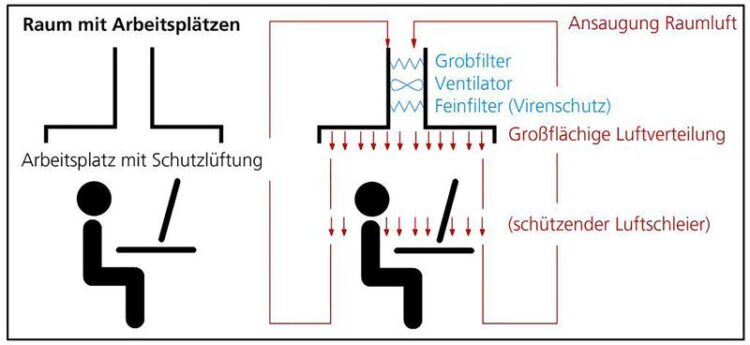A flow of fresh air protects against coronavirus

How the portable protective canopy works.
© Fraunhofer IBP
People who are required to serve a large number of customers at a checkout or counter are at a particularly high risk of exposure to COVID-19. At the Fraunhofer Institute for Building Physics IBP, a type of air lock was therefore developed to shield work stations from the surrounding air using constant ventilation. This “protective canopy” will be unveiled to the public from January 13 to 15, 2021, at the online BAU trade fair.
The coronavirus pandemic has fundamentally changed the way that many people think about hygiene. Who would have thought a year ago that we would be wearing masks in public and disinfecting our hands several times a day? People who work at counters or checkout areas, or who deal with many customers in general, are particularly affected. Many companies have improved virus protection with acrylic glass screens.
However, these do not offer comprehensive protection because the air can also carry viruses behind screens. To achieve better protection of affected workers, Fraunhofer IBP in Holzkirchen has developed the “protective canopy,” a kind of air lock that shields people at the checkout or counter from the air in the rest of the room. This technology will be exhibited to the public for the first time at the BAU trade fair, which is taking place online from January 13 to 15, 2021.
Portable protective canopy
The protective canopy is a handy air filter device no larger than a room humidifier that is easy to move to the work area on castor wheels. The device draws in the ambient air and filters it. The filtered air is then directed through a hose to an air outlet positioned above the work station, similar to a modern cantilever parasol with the umbrella attached to a long arm. The filter built into the unit is a high-efficiency particulate air (HEPA) filter that is so fine it can even hold back virus particles.
The air then flows out of the outlet like in a shower. This constant flow of air prevents ambient air from entering the work area. “When developing the unit, it was important for us to build a small, practical device that can be supplied with power using a standard plug,” says Dr. Victor Norrefeldt, group leader of aircraft and vehicle air conditioning at Fraunhofer IBP. “That way there is no need to interfere with the overall entire building control system. Instead, we can create a simple, individual solution.”
Indoor climate laboratory tests
Victor Norrefeldt and his team are currently testing the protective canopy in the Fraunhofer IBP indoor climate laboratory. The aim is to adjust the system so that the airflow does not cause an unpleasant draft but is still strong enough to keep out the surrounding air. “We can create air currents in the laboratory and then determine where the air is flowing by adding a tracer gas,” Victor Norrefeldt explains. “Our goal is a reliable protective canopy that separates the air while ensuring a pleasant working environment.”
The inspiration for such a protective canopy came from the “Air-Conditioning Canopy” project, which has occupied the experts at Fraunhofer IBP for a long time. They developed a system that can specifically cool the head area. “A common problem indoors is that your feet get cold on the floor, but your head is warm because hotter air rises,” explains Norrefeldt. “With the air-conditioning canopy, we can target cooler air at individual areas. Thanks to this technology, it is possible to set the room temperature so that your feet remain pleasantly warm, but your head stays cool.”
Weitere Informationen:
https://www.fraunhofer.de/en/press/research-news/2021/january-2021/a-flow-of-fre…
Media Contact
All latest news from the category: Machine Engineering
Machine engineering is one of Germany’s key industries. The importance of this segment has led to the creation of new university degree programs in fields such as production and logistics, process engineering, vehicle/automotive engineering, production engineering and aerospace engineering among others.
innovations-report offers informative reports and articles covering technologies such as automation, motion, power train, energy, conveyor, plastics, lightweight construction, logistics/warehousing, measurement systems, machine tools and control engineering.
Newest articles

Properties of new materials for microchips
… can now be measured well. Reseachers of Delft University of Technology demonstrated measuring performance properties of ultrathin silicon membranes. Making ever smaller and more powerful chips requires new ultrathin…

Floating solar’s potential
… to support sustainable development by addressing climate, water, and energy goals holistically. A new study published this week in Nature Energy raises the potential for floating solar photovoltaics (FPV)…

Skyrmions move at record speeds
… a step towards the computing of the future. An international research team led by scientists from the CNRS1 has discovered that the magnetic nanobubbles2 known as skyrmions can be…





















